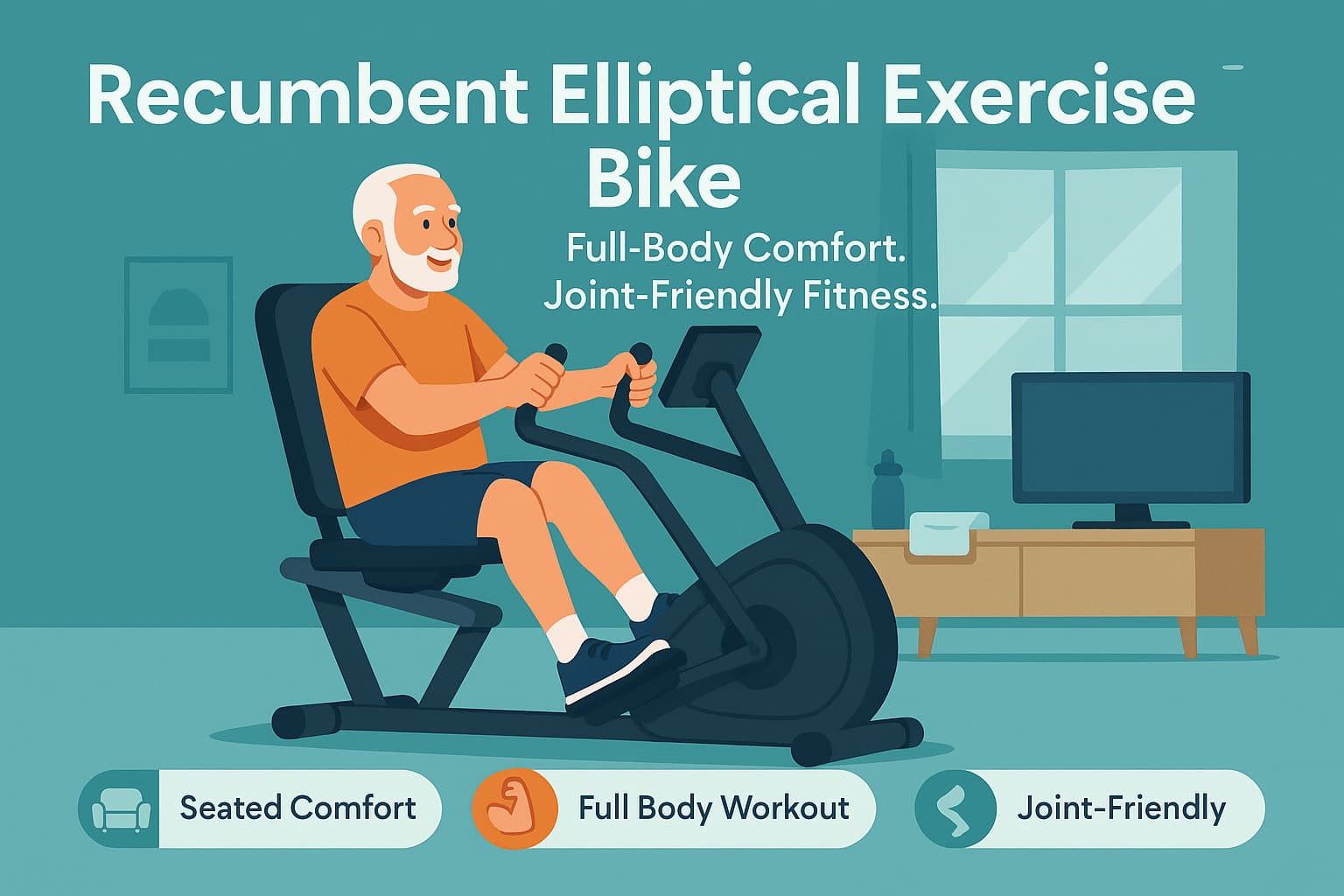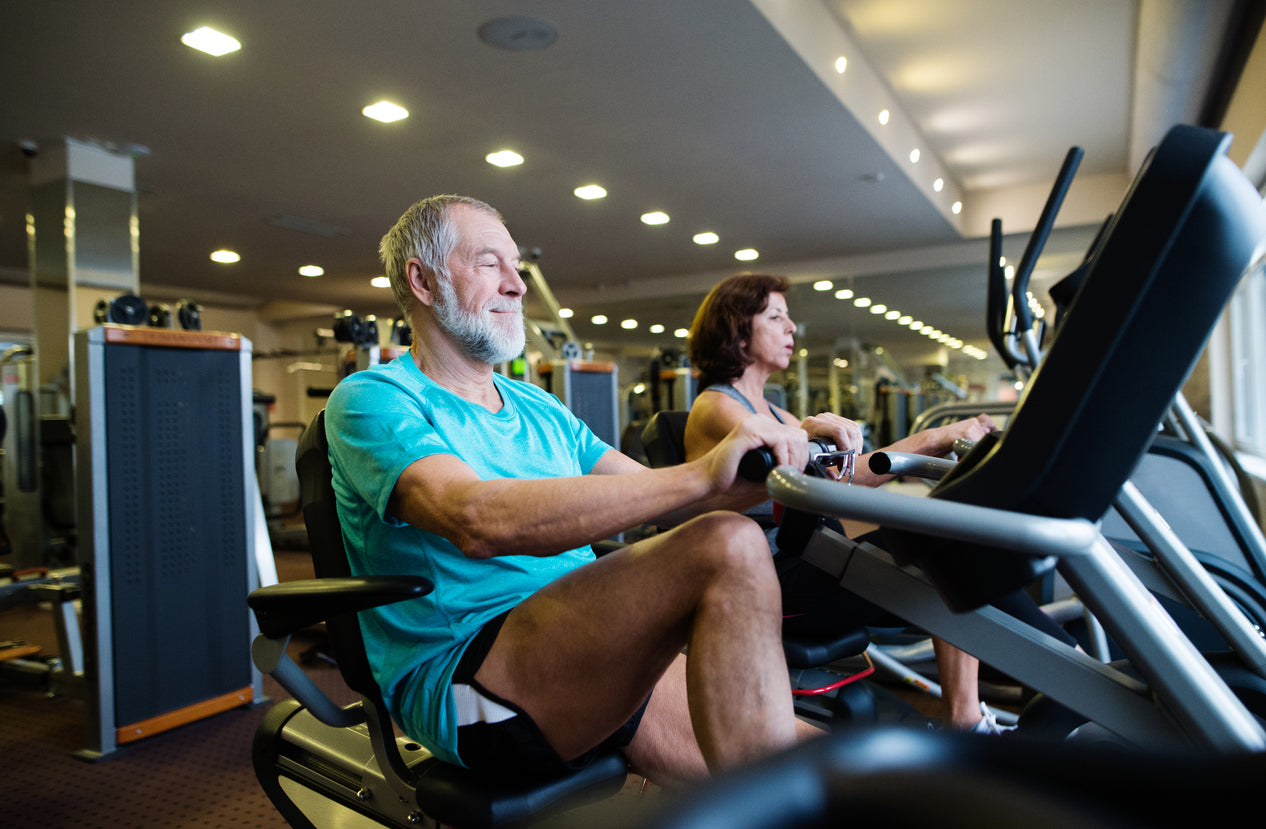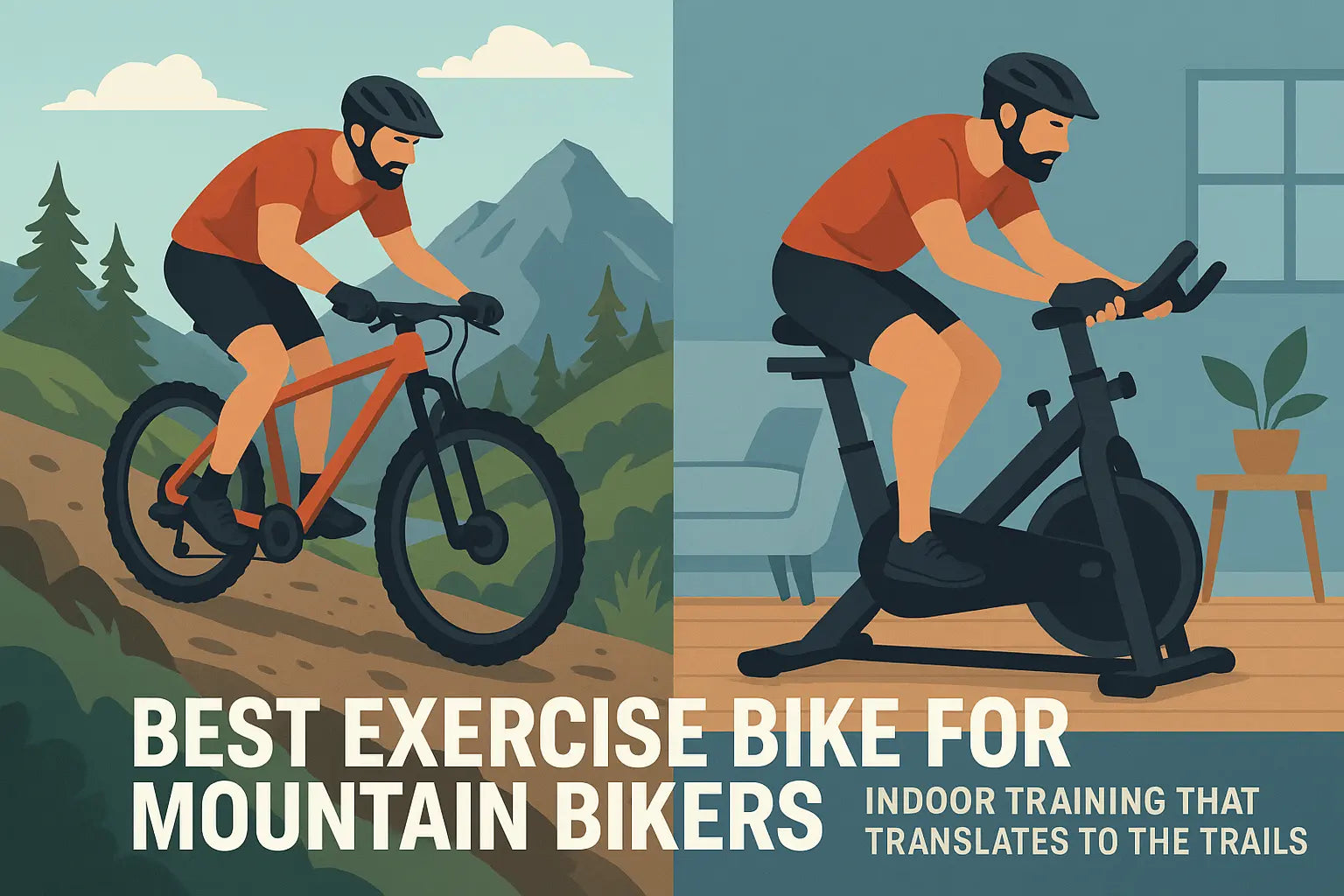
You might wonder, “Recumbent Bike vs Walking—which one truly boosts your health and fitness?” Your answer depends on what you want for your fitness and well-being. Some people focus on heart health. Others want to improve strength, well-being, or daily fitness. Your well-being can improve with either choice. Both activities support fitness and overall health. You decide what fits your health journey and supports your long-term well-being.
Key Takeaways
-
Recumbent biking is gentle on your body. It helps protect your joints. This makes it good for people with injuries. It is also good for people with joint pain.
-
Walking helps make your bones stronger. It keeps your bones healthy. It helps your whole skeleton stay strong.
-
Each activity has special benefits. Recumbent biking burns more calories quickly. Walking lets you get fresh air. Walking also gives you chances to meet people.
-
Think about your fitness goals before you choose. Also think about your daily life. You can do both for a balanced routine.
-
Liking your exercise helps you keep doing it. Pick the activity that feels best for you. This will help you stay motivated and get healthier.
Recumbent Bike Benefits
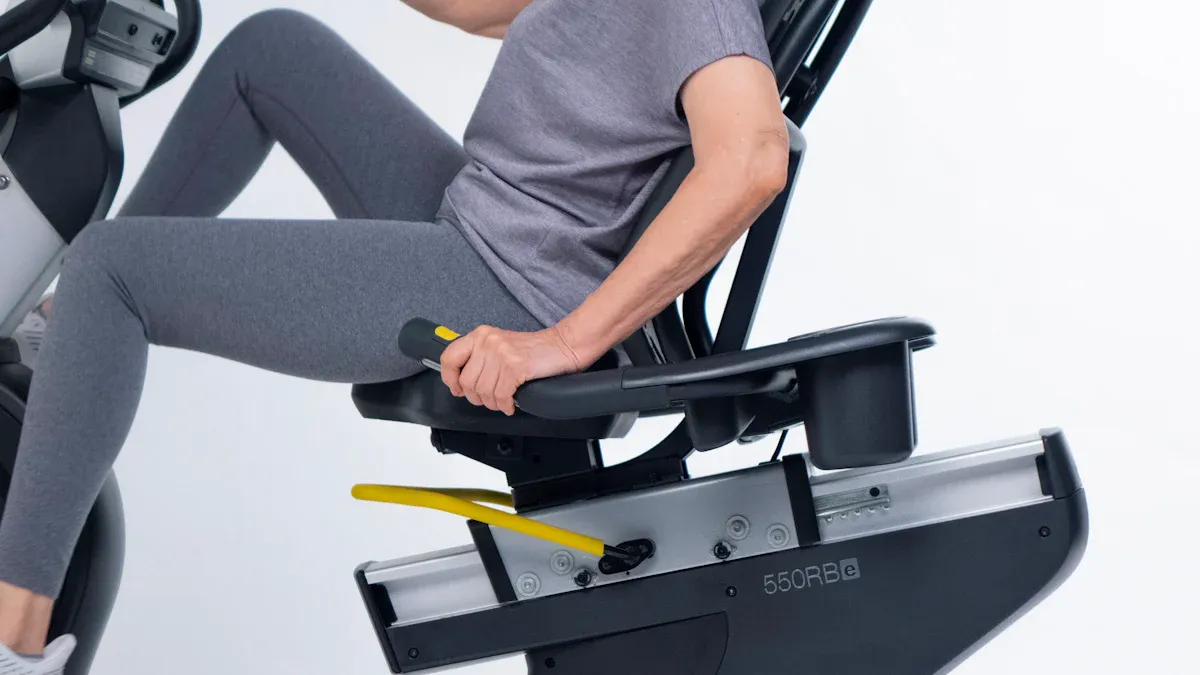
Low-Impact Exercise
You want exercise that is gentle on your body. Recumbent bikes are easy on your joints. You can cycle without hurting your knees or hips. This is good if you are healing from an injury or want to stay safe. Many people say cycling on a recumbent bike means less pain and quicker healing.
-
Recumbent bikes give good support and help your knees feel better.
-
The seat lets your hips stay steady, which helps if you are hurt.
-
You get a comfy ride that is soft on your joints.
Comfort and Support
Comfort is important when you work out. Recumbent bikes have big seats and a leaning backrest. This helps your spine and lower back feel good. You can ride longer and not get sore.
-
The seat spreads your weight so you do not feel pressure.
-
The leaning seat helps you stay steady, which is great for older people or anyone who has trouble with balance.
-
You get cycling benefits with less chance of hurting your back.
🛒 Looking for a Recumbent Bike?
Joint Health
If you want to keep your joints safe, recumbent bikes are smart. Cycling is gentle on your joints. The smooth movement helps your knees and hips move easily.
-
Cycling makes muscles around your knees stronger and protects them.
-
Pedaling helps move fluid in your joints to keep them healthy.
-
You get cycling benefits and lower your chance of getting hurt.
Adjustable Intensity
You choose how hard you work on a recumbent bike. You can start slow and make it harder as you get stronger. This helps you match your workout to your own level.
-
Recumbent bikes might not burn the most calories fast, but you can ride longer because they are comfy.
-
Cycling helps you build muscle and burn calories at your own speed.
-
You can change the settings for a gentle ride or a tough workout.
Indoor Convenience
You do not need to worry about rain or busy roads. Recumbent bikes let you cycle inside. This is great if you have trouble moving or want a safe way to exercise.
Recumbent bikes are good for older people or anyone who cannot move easily. The easy seat, adjustable parts, and helpful design make starting simple. You can watch your progress and try new routines to keep it fun.
You get all the cycling benefits, like stronger muscles, better joint health, and less chance of injury, right at home.
Recumbent Bike Disadvantages
Cost and Space
Recumbent bikes can cost more than you think. They are often pricier than other home exercise machines. Look at this table to compare prices:
|
Equipment Type |
Average Cost |
|---|---|
|
Recumbent Bikes |
$200 |
|
Standard Upright Bikes |
$200 |
|
Foldable Upright Bikes |
$120 |
You pay extra for comfort and support. That is a big downside. Recumbent bikes also need a lot of space. Most take up 8 to 9 square feet. This can be hard if your home is small. You should plan where to put the bike before you buy it.
Limited Weight-Bearing
Recumbent bikes are easy on your joints. But they do not help your bones get stronger. Here are some reasons why cycling is not great for bone health:
-
Recumbent biking does not make your bones stronger. It is not a weight-bearing activity.
-
Walking helps your bones stay healthy. Cycling does not give you this benefit.
If you want stronger bones, add other activities to your workout.
Accessibility Issues
Some people have trouble using recumbent bikes. It can be hard for those with mobility problems. Here are some common issues:
-
It is tough to find bike paths and parking for disabled riders.
-
Special equipment costs more and is hard to get.
-
Safety can be a problem. If you have trouble moving or balancing, cycling can be risky.
-
Some people feel left out or judged because of social stigma.
These problems can make cycling less fun for people with disabilities.
Upper Body Engagement
Recumbent bikes do not work your upper body much. Other bikes use your arms and shoulders more. Here is a table to show the difference:
|
Muscle Group |
Recumbent Bike |
Upright Bike |
|---|---|---|
|
Upper Body |
Little to no upper body engagement. |
Some upper body activation, especially in standing positions. |
You do not build arm or shoulder strength on a recumbent bike. This is a downside if you want a full-body workout. You will need to do other exercises too.
Tip: Try using light weights or resistance bands. This can help you get a better workout and fix this problem.
Walking Benefits

Accessibility
You can start walking almost anywhere. You do not need fancy gear or a gym membership. Walking works for all ages and abilities. Kids, adults, and seniors can enjoy the benefits. People with disabilities also see big improvements in their health and independence when they add walking to their routine. Take a look at these findings:
|
Study Title |
Key Findings |
|---|---|
|
Differences in physical aging measured by walking speed |
|
|
Walking activity increases physical abilities and subjective health in people with seven different types of disabilities |
Walking boosts physical and mental health for people with disabilities. |
You get easy access to fitness and health, no matter your background.
Weight-Bearing Exercise
Walking is a weight-bearing exercise. Your bones get stronger every time you step. You build bone density and keep your skeleton healthy. Here are some benefits you get from weight-bearing activities like walking:
-
Exercise keeps your bones strong as you age.
-
Short bursts of movement help your bones stay healthy.
Regular walking and other weight-bearing activities slow bone loss and can even build new bone. Your bones get stronger because walking puts gentle stress on them.
Social and Outdoor
You can walk with friends, family, or neighbors. Walking outdoors gives you fresh air and sunshine. You see trees, birds, and flowers. You feel less stressed and more relaxed. Studies show that walking in nature lowers depression risk and boosts your mood.
|
Study Title |
Findings |
|
|---|---|---|
|
Stanford researchers find mental health prescription: Nature |
Walking in nature reduces depression risk and brain activity linked to depression. |
|
|
Effects of Outdoor Walking on Positive and Negative Affect |
Green spaces lower rates of depression and improve well-being. |
|
|
A Walk in the Woods May Boost Mental Health |
Nature walks lower stress and improve mental health. |
You get social benefits and mental health boosts every time you step outside.
Easy to Start
You do not need special training to begin walking. You can start slow and build up your fitness. Many beginners follow a simple plan. Here is a sample schedule for your first month:
|
Week |
Day |
Activity |
|---|---|---|
|
1 |
1-7 |
Walk 10 minutes each day |
|
2 |
1-7 |
Walk 15 minutes each day |
|
3 |
1-7 |
Walk 20 minutes each day |
|
4 |
1-7 |
Walk 25 minutes each day |
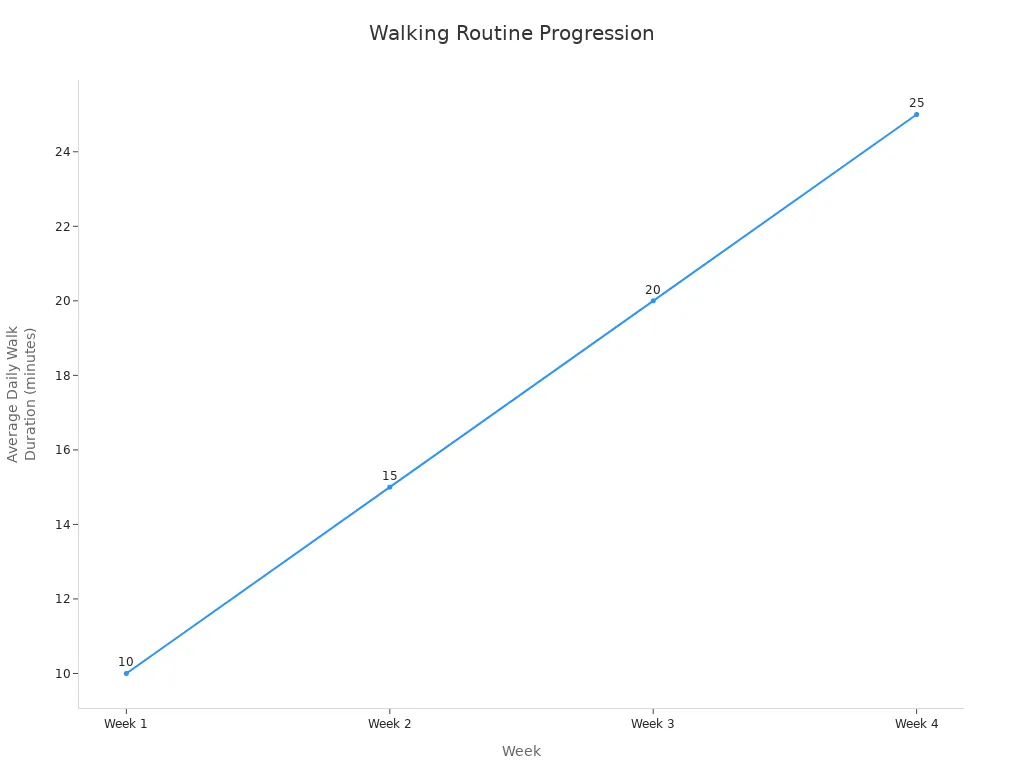
You can see your progress and feel proud of your achievements. Walking fits into your life with no stress.
Health Impact
Walking gives you many health benefits. You lower your risk of heart disease, stroke, and high blood pressure. You burn calories and build muscle. Your body fat drops and your fitness improves. Studies show that walking for 30 minutes a day can cut your risk of heart disease by almost 20%. Here are some more benefits:
-
Walking more than 4 hours a week lowers your chance of heart problems.
-
You get these benefits at any age.
-
Walking helps you live longer and feel better.
|
Study |
Findings |
|---|---|
|
Murtagh et al. |
|
|
Paula et al. |
Walking 15-20 minutes a day lowers blood pressure. |
You get strong muscles, better fitness, and a healthier life. The benefits of walking touch every part of your health.
Walking Disadvantages
Joint Impact
You might think walking is always gentle, but it can put stress on your joints. If you walk often or for long distances, your knees and feet can feel sore. Research shows that higher plantar pressure during walking links to a bigger risk of bone stress injuries. Runners who get these injuries often have more pressure on their joints when they walk. This means you need to watch out for pain or swelling, especially if you have past injuries or joint problems.
If you feel pain in your knees or feet after walking, take a break and let your body recover. This helps prevent further loss of joint health.
Weather Dependent
One of the main disadvantages of walking is the weather. Rain, snow, or extreme heat can stop you from going outside. Studies show that when you see weather as a barrier, you walk less. Both cold and hot days can lower your motivation. If you always worry about the weather, you might skip your routine more often.
-
You lose consistency in your walking schedule.
-
Weather changes can lead to loss of progress.
Calorie Burn
Walking helps with weight loss, but the calorie burn depends on your speed and weight. Slow walking burns fewer calories, so you may need to walk longer to see results. Here’s a quick look at how many calories you burn at different speeds and weights:
|
Weight (lbs) |
2.5 mph |
3.5 mph |
4.0 mph |
|---|---|---|---|
|
125 |
~50 |
~60 |
~70 |
|
150 |
~60 |
~70 |
~85 |
|
175 |
~70 |
~85 |
~100 |
|
200 |
~80 |
~95 |
~110 |
|
225 |
~90 |
~105 |
~125 |
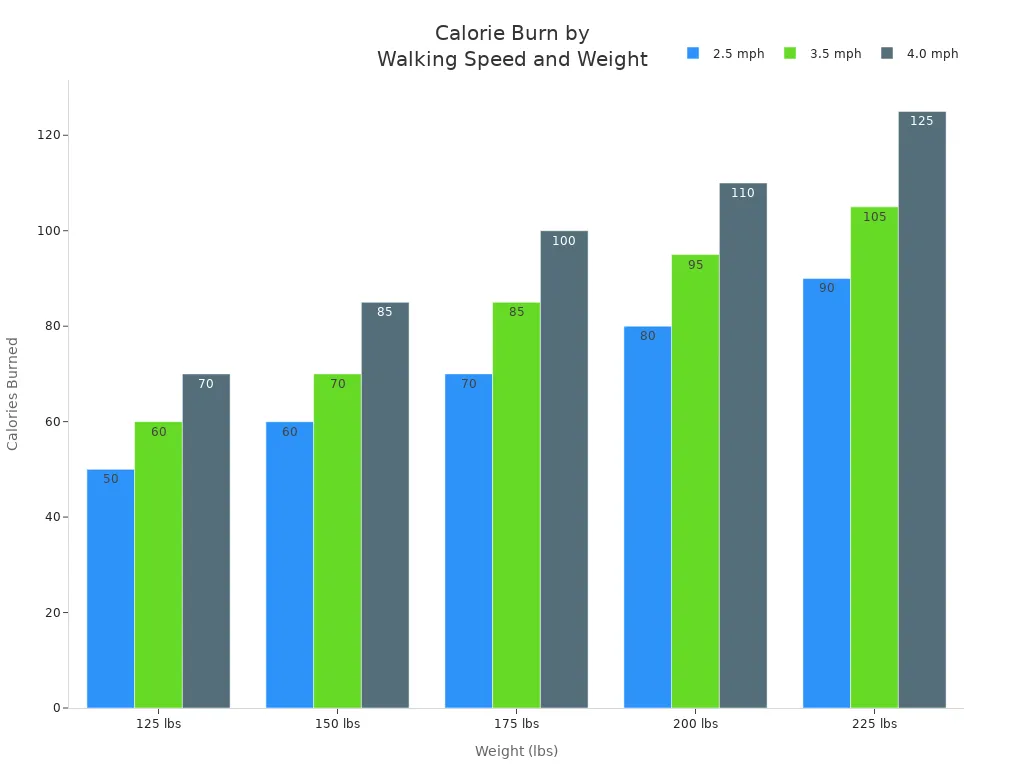
You burn more calories at faster speeds, but slow walking means slower weight loss. Over time, this can be one of the disadvantages if you want quick results.
Limited Resistance
Walking does not let you adjust resistance easily. You use your body weight, but you cannot make your muscles work harder unless you add hills or weights. Studies show that combining aerobic and resistance exercise improves walking performance more than walking alone. If you want to build muscle or prevent loss of strength, you need extra exercises.
-
Walking alone may not help with muscle loss.
-
You need to add resistance training for better results.
Boredom Factor
Walking can feel boring if you do the same route every day. Research highlights that boredom affects your motivation and self-control. If you feel dull or uninterested, you might skip your walks. The Bored of Sports Scale shows that some people lose interest quickly, which leads to loss of routine and fitness.
Try changing your route, listening to music, or walking with friends to fight boredom and avoid these disadvantages.
Recumbent Bike vs Walking: Exercise Comparison
Calorie Burn
You want to know which activity helps you burn more calories. When you look at cycling vs walking, the numbers show a clear difference. Recumbent biking can help you burn more calories in less time, especially if you push yourself. Walking burns calories too, but you need to walk faster or longer to match the calorie burn of cycling.
Here’s a quick table to compare calorie burn for a 30-minute session:
|
Intensity |
Recumbent Biking (calories) |
Walking (calories) |
|---|---|---|
|
Light |
~240 |
~154 |
|
Moderate |
~285 |
~179 |
|
High |
~357 |
~250 |
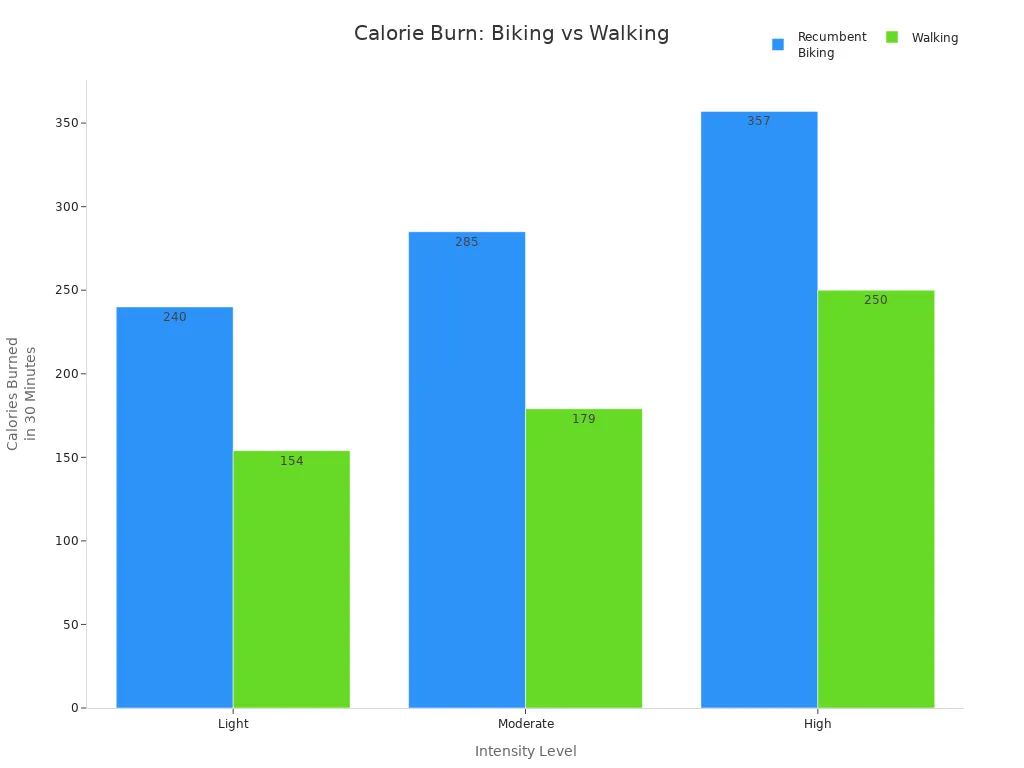
If you want faster weight loss, recumbent biking at moderate or high intensity gives you an edge. Walking is great for steady calorie burn, but cycling vs walking shows that biking wins for quick results. You can adjust the resistance on a recumbent bike to make your exercise harder and boost your calorie burn. Walking does not let you change resistance as easily, so you need to walk uphill or add weights for more challenge.
Joint and Bone Health
You care about your joints and bones. Recumbent biking is a low-impact exercise. It protects your knees, hips, and ankles. The smooth motion of cycling means less pain and less risk of injury. If you have arthritis or joint pain, cycling vs walking makes recumbent biking a safer choice. You can exercise without hurting your joints.
Walking is a weight-bearing exercise. Every step puts gentle stress on your bones. This helps you build bone density and keeps your skeleton strong. If you want improved cardiovascular health and stronger bones, walking is a good option. But walking can cause joint discomfort, especially if you have knee or hip problems. The heel-to-toe motion in walking gives your bones a boost, but it may lead to pain over time.
Tip: If you want to protect your joints, choose recumbent biking. If you want stronger bones, walking is better. You can mix both exercises for balanced health.
Accessibility and Convenience
You want exercise that fits your life. Recumbent bike vs walking gives you two easy options. Walking is simple. You do not need special equipment. You can walk anywhere—at home, in the park, or around your neighborhood. Walking is great for all ages and abilities. You can start slow and build up your fitness.
Recumbent biking is also convenient, especially if you want to exercise indoors. You do not need to worry about weather or busy streets. The bike gives you comfort and support. You can track your progress and adjust your workout. Cycling vs walking shows that recumbent biking is perfect for people with mobility issues or those who want a safe, indoor exercise.
Note: Walking is free and easy to start. Recumbent biking costs more and needs space, but it offers comfort and safety. Choose the exercise that matches your lifestyle.
Suitability for Different Ages
You want exercise that works for your age and health. Recumbent bike vs walking gives you choices for every stage of life. Cycling vs walking shows that both activities help you reach your fitness goals.
-
Recumbent biking is recommended for older adults. It helps you meet WHO physical activity guidelines.
-
Studies focus on adults aged 60-79 and 80+ years. Cycling improves cardiovascular health and muscle strength.
-
Recumbent biking is low-impact. It reduces injury risk and is easy on your joints.
-
You do not need much motor control. The bike is safe for people with mobility issues.
-
Recumbent biking gives you similar cardiovascular benefits to walking. It is great for people with knee or back problems.
-
At moderate to high intensity, recumbent biking burns more calories than walking.
Walking is also good for all ages. Kids, adults, and seniors can enjoy walking. You get improved cardiovascular health, stronger bones, and better fitness. Walking is easy to start and fits into your daily routine. If you want weight loss, walking helps you burn calories and lose body fat.
If you are older or have joint pain, recumbent biking is a safe choice. If you want strong bones and easy access, walking is perfect. Cycling vs walking lets you pick the best exercise for your age and health.
How to Choose for Your Health
Assess Your Fitness Goals
Start by thinking about what you want from your exercise. Do you want to boost your heart health, lose weight, or just feel better every day? Your goals help you pick the right activity. Some people want to burn more calories in less time. Others need something gentle for their joints. Take a look at this table to see when each activity fits best:
|
Activity |
When to Choose |
|---|---|
|
Recumbent Biking |
- Want higher calorie burn in less time |
|
|
- Need joint-friendly cardio |
|
|
- Prefer indoor workouts |
|
|
- Are recovering from a lower-body injury |
|
Walking |
- Prefer outdoors and fresh air |
|
|
- Need weight-bearing exercise for bone health |
|
|
- Have limited space or budget |
|
|
- Want to combine movement with errands or social time |
You can use this guide to match your health needs and fitness goals.
Consider Comfort and Enjoyment
You stick with exercise when you enjoy it. Ask yourself which activity feels better for your body. Some people love the comfort of a recumbent bike. Others feel happy and relaxed while walking outside. If you like what you do, you will keep moving and improve your health. One 68-year-old shared,
“Riding my recumbent elliptical while reviewing vocabulary helped me finally stick with my Spanish practice. It’s now my favorite part of the day.”
Mixing exercise with something fun, like music or learning, can make your routine the best part of your day.
Match to Your Lifestyle
Your daily life matters when you choose exercise. Walking works well if you want to get fresh air, meet friends, or run errands. Recumbent biking is great if you need to stay indoors or want a safe, joint-friendly workout. You can even combine both for better health and fitness. Studies show that mixing physical and mental activities, like biking and learning, improves memory and attention. Regular aerobic exercise also boosts brain health by raising BDNF, a protein that helps your brain grow and stay strong.
-
Combining walking and biking keeps your routine fresh.
-
You get more health benefits and avoid boredom.
-
Your fitness improves faster when you mix things up.
Tip: Try both activities to see which one fits your health, fitness, and lifestyle best. You might find that a mix gives you the most benefits.
You have two great ways to get healthier and stronger. Recumbent biking helps you burn more calories. It is gentle on your joints. You can exercise inside and stay comfortable. Walking lets you go outside and enjoy fresh air. It helps your bones get stronger. Walking is easy to start and does not cost much. Both activities help your heart, muscles, and weight loss. You can watch TV while cycling or talk with friends while walking. Each one makes you feel happier and less stressed. Choose the one that matches your life and health needs. Doing both cycling and walking gives you even more health benefits. Keep moving to make your heart and body strong!
-
Recumbent biking:
-
Burns more calories
-
Easy on joints
-
Indoor exercise
-
Helps you heal from injuries
-
-
Walking:
-
Lets you enjoy the outdoors
-
Makes bones stronger
-
Saves money
-
Good for social time and multitasking
-
You can pick cycling, walking, or do both. Your heart, muscles, and health will get better. Every step or pedal helps you reach your goals for a healthy heart and losing weight.
FAQ
Can you lose weight with a recumbent bike or walking?
You can lose weight with both. Recumbent biking burns more calories in less time. Walking helps you stay active every day. Pick the one you enjoy most. Staying consistent matters more than the activity.
Is a recumbent bike safe for people with joint pain?
Yes, you get a gentle workout with a recumbent bike. The seat supports your back and hips. You avoid extra stress on your knees and ankles. Many people with arthritis or injuries choose this option.
What are the main disadvantages of walking?
You might face joint pain if you walk long distances. Bad weather can stop you from going outside. Slow walking burns fewer calories. You may get bored if you follow the same route every day.
Can you combine walking and recumbent biking in your routine?
You can mix both activities. Try walking on sunny days and cycling indoors when it rains. This keeps your workouts fresh. You get more health benefits and avoid boredom.
Which exercise is better for older adults?
Both work well for older adults. Recumbent biking protects your joints and helps with injury recovery. Walking builds bone strength and supports independence. Choose the one that feels best for your body.
Latest Articles






